6 type of melons | How to buy and store melons
6 popular types of melons
Our guide to 6 of the most delicious melons available in New Zealand
Melons are one of the juiciest, most thirst quenching fruits in the world. Native to Central Asia, melons are widely grown in warmer countries where they thrive in the intense sun. The melon plant is cultivated for its musky smell and delicious soft fruit. Most melons sold here belong to the cucurbit family, which also includes cucumbers and squash. Cantaloupes, also known as rockmelon, are from the reticulatus group of melons (Cucumis melo variant)
Melons are in season in New Zealand from December to March.
Popular types of Melon
The most popular melons available to buy in New Zealand are watermelon, honeydew melon, rockmelon (also known as cantaloupe or muskmelon) and Orange Candy melon. Galia melon and winter melon are also occasionally available here.

Watermelon
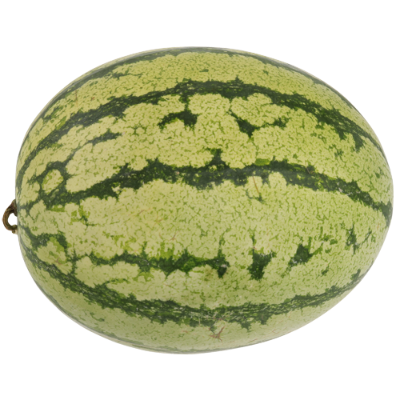
Watermelons are a large fruit, spherical in shape and can weigh up to 15kg, which is why they are often sold by weight. They have a smooth, green striped outer body, with a bright red flesh, which is juicy and sweet and speckled with edible black melon seeds.
When selecting a watermelon look for one which is heavy, with a dull skin and a bright yellow blemish which indicates it's mature. Try tapping the bottom, a ripe melon will sound hollow. Immature melons will sound dull. Watermelon is perfect eaten raw. This thirst quenching fruit contains 90% water and can cool you down on the hottest days. You can actually grill, and barbecue watermelon, to bring out a sweet caramelised flavour. It pairs well with salty foods and makes a deliciously refreshing watermelon juice.
Honeydew Melon
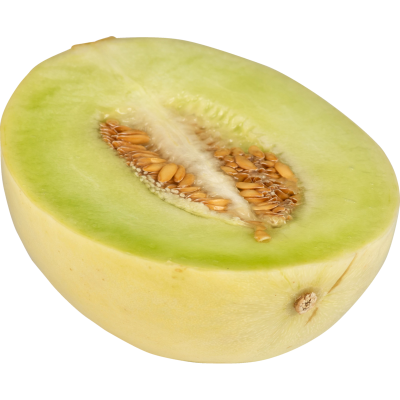
Honeydew melon is oval in shape with a dull, smooth, yellow body and a mild flavoured, pale green colored flesh. It should feel heavy for its size and have a deep aroma when mature. Honeydew melon has a milder, less sweet flavour than some of its sister variants. Dice and add to fruit salads, desserts, fruit smoothies and cold soups.
Rockmelon/Cantaloupes
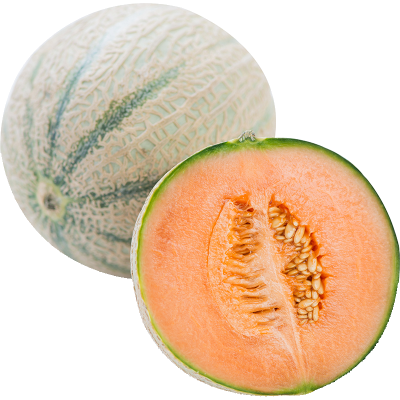
The names rockmelon, cantaloupe melon and muskmelon all refer to the same fruit. Rockmelon have a round green body, with a well pronounced netting imprint over the skin surface when they reach maturity. Soft spots indicate it's over ripe. It will have a deep exotic aroma and be firm to the touch. Salty prosciutto and cheese are the cantaloupes' best friends. When you don't have time to cook, cantaloupe will rise to the challenge, creating an impressive range of savoury dishes when paired with most salty foods. The sweet orange flesh of rock melon is perfect to freeze when diced, it makes beautiful creamy ice creams and refreshing sweet sorbets and granitas.
Orange Candy Melon
Orange Candy melon is a relatively new Amarillo melon variety, grown in Queensland, Australia. Its smooth, bright sunny yellow skin reveals a firm orange flesh, which is crisp like a nashi pear and full of flavour. You can juice and blend Orange Candy melon into smoothies and slushies. It pairs well again with foods with a salty taste profile particularly in a grilled halloumi salad.
Galia melon
Galia melon is a deliciously sweet and fragrant hybrid of the cantaloupe and honeydew melons. This melon is in season late summer to early autumn (January–March). It isn’t produced in as abundance as honeydew melon so is often imported from Australia.
Galia pairs well with citrus, feta, berries, yoghurt, mint, lime and prosciutto. It is a delicious accompaniment fruit salads and smoothies and a wonderful counterbalance to spicy or salty dishes.
Winter melon (Ash Gourd)
Winter melon (also known as ‘Ash Gourd’) is different from regular ‘sweet’ melons. They are very watery with a very slight, subtle taste and are used mostly as a ‘vegetable’ in cooking. They are not eaten raw.
Health benefits of melon
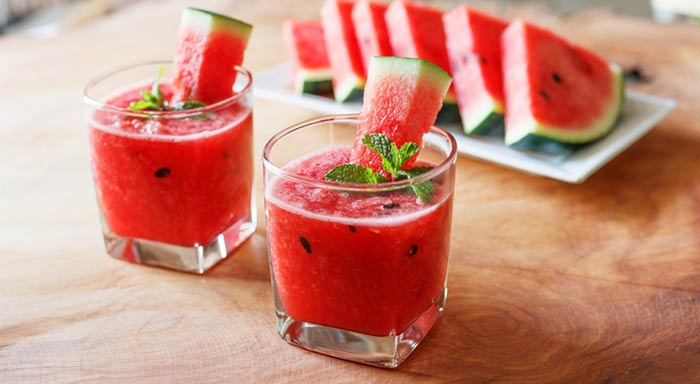
Melons are full of water, making them refreshing and hydrating in hot weather. Despite their sweet taste, most melons contain very little sugar, so can be consumed freely even on a weight loss program. Melons have a low salt, low fat and low cholesterol content. They are a good source of vitamins and minerals.
Rockmelon is a healthy rock star, with about 30 times the beta carotene of oranges in its deep orange flesh. They boost your immune system, improve skin and promote healthy brain function. They are also the sweetest melon, so go ahead and enjoy them.
Melon nutrition (per 100 grams)
Watermelon
Calories: 30
Carbs: 7.5 g
Sugar: 6.2 g
Fibre: 0.4 g
Rockmelon / Cantaloupe
Calories: 36
Carbs: 9.1 g
Sugar: 7.9 g
Fibre: 0.9 g
Honeydew Melon
Calories: 36
Carbs: 9.1 g
Sugar: 8.1 g
Fibre: 0.8 g
Orange Candy Melon
Calories: 40
Carbs: 10 g
Sugar: 9 g
Fibre: 0.8 g
Galia melon
Calories: 34
Carbs: 8.2 g
Sugar: 7.9 g
Fibre: 1.0 g
Winter melon (Ash Gourd)
Calories: 13
Carbs: 3.0 g
Sugar: 1.6 g
Fibre: 0.5 g
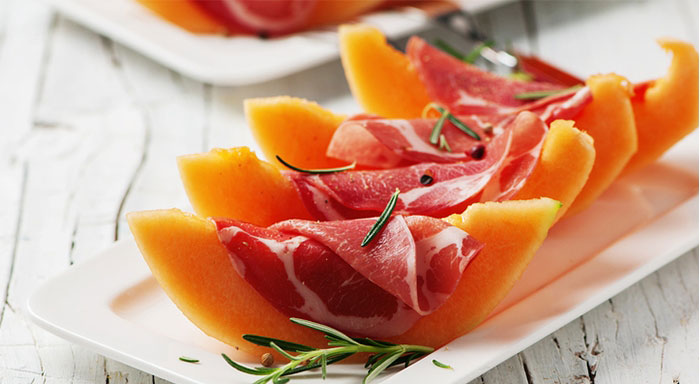
Buying and storing melons
Melons can be bought whole, half, sliced and diced. Once picked melons do not ripen further so when buying, select with care.
- Press lightly at the flower end, it should give just a little
- Smell and look for a sweet, heady aroma
- Look for a pronounced netting imprint on the skin of netted melons. This suggests ripeness.
- The skin of melon can harbour bacteria, so scrub under cold water before cutting or storing away.
- Once cut, store the melon in the refrigerator and consume within 3 days. Any longer and the melon tends to become slimy.
Delicious ways to eat melon
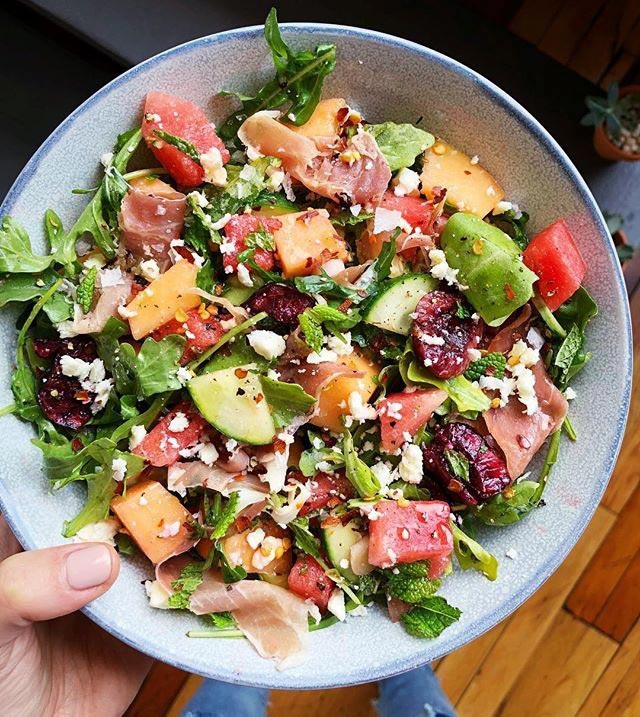
Melons are spectacular when eaten fresh without any cooking. Generally you should remove the seeds and skin from the melon before eating. The exception to this is watermelon where the seeds are edible. They enhance both sweet and savoury dishes
- Slice to go
- Dice into chunks and add to a salty feta salad with peppery greens
- Pair rockmelon with salty prosciutto and olives for delicious antipasto.
- Juice and chill for a refreshingly fresh drink
- Char slices on the BBQ to caramelise
- Finely dice watermelon and mix with chilli, lime juice, green onion and coriander for an amazing salsa
- Make sorbet or granitas with a little lemon or lime juice
- Make a sweet, tangy, chilled melon soup
- Dice and top with fresh yoghurt
- Chop and add to a fresh fruit salad
Rediscover melons
Now that you know what to look for, pick up a melon with your next shop and get creative in the kitchen. Melons help you feel great and now you know how to incorporate them into both sweet and savoury dishes. Find out more about seasonal fruits and vegetables here.
Read more Fruit and Vegetable guides
Pumpkin | Kumara | Silverbeet | Asparagus | Watermelon | Afourer Mandarin | Cherry Tomato | Mushrooms | Avocado | Grapefruit | Broccoli | Celery | Potatoes | Oranges | Strawberries